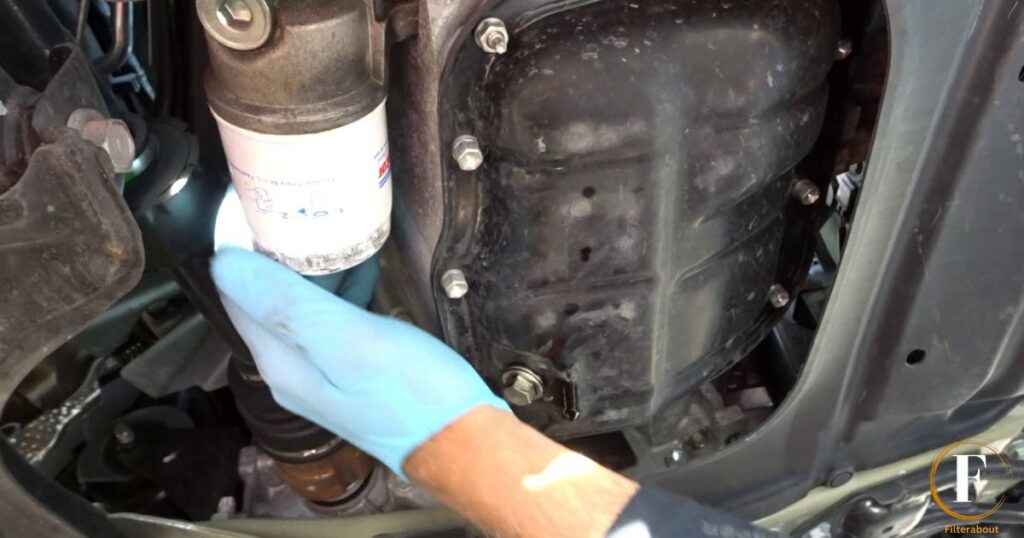Cutting open an engine oil filter involves slicing through its metal casing to inspect its internal components. This process helps reveal any debris, metal particles, or signs of wear, providing insights into the engine’s overall health and the effectiveness of the oil filtration system.
Curiosity was piqued about what lurked inside the engine oil filter. How to Cut Open an Engine Oil Filter and What to Look For? With four straightforward steps. Grab a filter cutter carefully open it up examine for any metal bits and guarantee a longer life for your engine. It’s like unlocking a hidden treasure; the process is easier than you imagine.
Cut open an engine oil filter using a sharp utility knife. Begin by removing the filter from the vehicle and draining any excess oil. Carefully cut along the seam of the filter exposing the filter media inside. Inspect for metal particles debris or unusual textures as these could indicate engine issues.
How to cut open an engine oil filter
Cutting open an engine oil filter can provide valuable insights into the health of your vehicle’s engine. To begin gather the necessary tools including a filter cutter or a reciprocating saw, safety gloves, and eye protection.
Start by removing the oil filter from the engine using an oil filter wrench. Once the filter is detached place it in a secure vice to prevent any accidents.
With the oil filter secured carefully use the filter cutter or reciprocating saw to make a clean cut along its length. Ensure the cut is straight and even to expose the filter media inside.
Take note of any debris, metal particles, or sludge present in the filter these could indicate engine wear or other potential issues. Analyzing the contents can help you gauge the overall condition of your engine and whether there are any signs of impending problems.
Cutting open an engine oil filter is a useful practice for DIY enthusiasts and automotive professionals alike. By inspecting the filter’s interior you gain valuable information about the engine’s performance and can take preventive measures to address potential concerns.
Regularly performing this procedure can contribute to the overall health and longevity of your vehicle. So remember to Cut Open an Engine Oil Filter for a closer look at your engine’s well-being.
Engine oil filter inspection guide

| Step | Task |
| 1 | Gather necessary tools and materials, including safety gloves and a drain pan. |
| 2 | Park the vehicle on a level surface and allow the engine to cool down. |
| 3 | Locate the engine oil filter, typically found near the engine block. |
| 4 | Place the drain pan beneath the oil filter to catch any oil that may drip during removal. |
| 5 | Using an appropriate oil filter wrench, carefully loosen and remove the old oil filter. |
| 6 | Inspect the removed filter for any signs of damage, such as dents or leaks. |
| 7 | Check for the presence of metal particles or debris in the old filter, which may indicate engine issues. |
| 8 | Cut Open an Engine Oil Filter to further inspect for internal debris or issues. |
| 9 | Compare the old filter with the new one to ensure they match in size and specifications. |
| 10 | Apply a small amount of fresh engine oil to the rubber gasket on the top of the new filter, install it hand-tight, and dispose of the old filter responsibly. |
DIY oil filter analysis
DIY oil filter analysis is a simple yet effective way for car owners to assess their engine’s health. During an oil change, individuals can easily cut open the engine oil filter using basic tools.
This step, known as Cut Open an Engine Oil Filter allows for a quick visual inspection of the filter media, helping identify any signs of wear debris or contamination. This hands-on approach provides valuable insights, enabling timely maintenance and preventing potential engine issues.
Incorporating the Cut Open an Engine Oil Filter technique into routine maintenance empowers car enthusiasts to take a proactive stance in monitoring their vehicle’s well-being.
By routinely inspecting the filter’s condition, owners can spot early warning signs, addressing potential problems before they escalate. This DIY approach not only saves on future repair costs but also contributes to the overall longevity and performance of the engine.
Engine maintenance tips

- Routine Oil Changes: Regularly change the engine oil using the recommended oil grade and adhering to the intervals specified in your vehicle’s manual.
- Air Filter Inspection: Periodically inspect the air filter to ensure it is clean and unclogged, promoting optimal fuel efficiency and engine performance.
- Coolant Maintenance: Keep a close eye on coolant levels and top them up as needed to prevent engine overheating, especially during long drives.
- Drive Belt Inspection: Regularly inspect the drive belts for signs of wear and tear. Replace them promptly to avoid unexpected breakdowns and ensure smooth engine operation.
- Battery Terminal Care: Check the battery terminals for corrosion, cleaning them regularly to maintain a reliable start and prevent electrical issues.
- Scheduled Maintenance: Adhere to your vehicle’s scheduled maintenance plan, addressing issues proactively to prevent major problems down the line.
- Deeper Analysis with Oil Filter: For a more in-depth assessment of your engine’s health consider incorporating the keyword Cut Open an Engine Oil Filter during routine changes. Examining the filter can provide insights into potential problems and help you address them early on.
What to look for in an oil filter
When choosing an oil filter for your vehicle consider factors like compatibility with your car’s make and model. Filters come in various sizes and thread patterns, so ensure you pick one that fits your engine properly. Check the Micron Rating for filtration efficiency, aiming for a lower rating to capture smaller particles and protect your engine from debris.
Pay attention to construction and materials. Opt for filters with a durable build, anti-drain back valves to prevent oil drainage when the engine is off, and a secure sealing gasket to avoid leaks. Regularly changing the oil filter during oil changes is vital for engine health.
For a deeper understanding, some enthusiasts Cut Open an Engine Oil Filter after use. This advanced step involves carefully examining a used filter to assess its effectiveness and inspect trapped contaminants. While not necessary for routine maintenance it provides insights into the engine’s condition and filter performance.
Preventive measures for engine health

Maintaining a healthy engine involves simple yet crucial preventive measures. Regular oil changes are paramount, with a recommended frequency of every 3,000 to 5,000 miles. Fresh oil ensures proper lubrication and removes contaminants, promoting optimal engine function.
Monitoring coolant levels is equally vital. Adequate coolant prevents engine overheating, a major contributor to damage. Regularly check and top up coolant levels, ensuring the right mixture for your vehicle.
For a more in-depth engine health check, consider the keyword Cut Open an Engine Oil Filter. During an oil change, inspecting the cut-open filter provides insights into potential issues like metal particles or debris. This proactive step helps detect problems early, contributing to a longer and healthier engine life.
Frequently Asked Questions
Why cut open oil filter?
Cutting open an oil filter allows inspection of internal debris metal fragments and overall filter condition, aiding in engine health assessment.
How do you use a filter cutter?
To use a filter cutter, secure the oil filter in the tool adjust the cutter to the desired height and rotate to cut.
How do you puncture an oil filter?
To puncture an oil filter use a sharp tool like a screwdriver or awl to create a hole. Ensure safety precautions and proper disposal afterward.
Conclusion
Understanding how to cut open an engine oil filter and what to look for is paramount for ensuring optimal engine health. This meticulous process provides valuable insights into the condition of the engine and the effectiveness of the filtration system. By carefully examining the filter’s interior, one can identify potential issues such as metal particles, sludge, or debris that may compromise engine performance. Regular inspection through this method enables proactive maintenance, preventing potential damage and extending the lifespan of the engine.
How To Cut Open An Engine Oil Filter And What To Look For? Is a crucial guide for automotive enthusiasts and professionals alike by incorporating this practice into routine maintenance, individuals gain a deeper understanding of their engine’s well-being, fostering a proactive approach to address potential concerns. Embracing this knowledge ensures smoother operations, enhances engine longevity, and contributes to overall vehicle reliability and performance.

Alexander Quinn is the author behind Filterabout.com. Known for expertise in diverse topics, Quinn’s content on the website reflects a versatile knowledge base catering to various interests.



![Jynxzi Age, Net Worth, Career[2024]](https://filterabout.com/wp-content/uploads/2024/05/Who-Is-Shanin-Blake-Age-Wiki-Parents-Dating-Net-Worth-300x148.jpg)
![Jynxzi Age, Net Worth, Career[2024]](https://filterabout.com/wp-content/uploads/2024/05/Jynxzi-Age-Net-Worth-Career2024-300x148.jpg)


![Kutty Surumi Net Worth, Bio, Age[2024]](https://filterabout.com/wp-content/uploads/2024/05/Kutty-Surumi-Net-Worth-Bio-Age2024-300x148.jpg)



![Jynxzi Age, Net Worth, Career[2024]](https://filterabout.com/wp-content/uploads/2024/05/Who-Is-Shanin-Blake-Age-Wiki-Parents-Dating-Net-Worth-150x150.jpg)